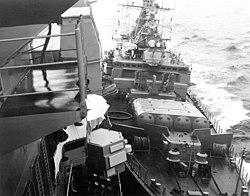 Bezzavetnyy is closest to the camera, the cruiser Zhdanov in the middle and the submarine tender Magomed Gadzhiev in the rear | |
| History | |
|---|---|
| Name | Bezzavetnyy |
| Ordered | 4 July 1973 |
| Builder | Zaliv Shipbuilding yard (Kerch) |
| Yard number | 14 |
| Launched | 7 May 1977 |
| Commissioned | 17 February 1978 |
| Decommissioned | 8 September 1997 |
| Fate | Transferred to Ukraine on 1 August 1997 |
| Name | Dnipropetrovsk |
| Acquired | 1 August 1997 |
| Decommissioned | October 2002 |
| Renamed | 1997 |
| Reclassified | "Technical property" (2002) |
| Identification | U134 |
| Fate | Scuttled on 12 May 2005 |
| General characteristics | |
| Class & type | Burevestnik-class frigate |
| Displacement | 3,300 tons standard, 3,575 tons full load |
| Length | 405.3 ft (123.5 m) |
| Beam | 46.3 ft (14.1 m) |
| Draft | 15.1 ft (4.6 m) |
| Propulsion |
|
| Speed | 32 knots (59 km/h; 37 mph) |
| Range | 4,995 nmi (9,251 km; 5,748 mi) at 14 knots (26 km/h; 16 mph) |
| Complement | 200 |
| Sensors & processing systems |
|
| Electronic warfare & decoys | Start suite with Bell Shroud intercept, Bell Squat jammer, 4 PK-16 decoy RL, 8 PK-10 decoy RL, 2 towed decoys |
| Armament |
|
The Ukrainian frigate Dnipropetrovsk was the former Soviet frigate (guard ship) Bezzavetnyy of the Burevestnik-class (NATO codename: Krivak I) built for the Soviet Navy in the late 1970s.
